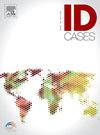Secondary adrenal insufficiency in a young man with HIV and pulmonary tuberculosis, complicated by cerebral toxoplasmosis and seizure
IF 1
Q4 INFECTIOUS DISEASES
引用次数: 0
Abstract
Secondary adrenal insufficiency (SAI) presents with non-specific clinical symptoms, which may overlap with those of HIV and tuberculosis, making diagnosis challenging. We report a case of a 22-year-old Indonesian man, presented with fatigue, intermittent dyspnea, intermittent nocturnal fever, and a significant weight loss of 5 kg over one month. He also reported having unprotected sex with a casual partner. Physically, he presented pale and weak with hypotension . Laboratory examination showed cortisol levels of 28.46 nmol/L and adrenocorticotropic hormone (ACTH) levels of 5.6 µg/dL. Chest x-ray and GeneXpert confirmed pulmonary tuberculosis. Despite an initial negative HIV examination, repeat testing was recommended due to the possibility of a false-negative result. Therefore, the initial diagnosis was SAI due to HIV and tuberculosis. He was treated with hydrocortisone and supportive therapy. Following outpatient discharge, he was re-admitted due to severe headaches, vomiting, and a generalized tonic-clonic seizure. Neuroimaging revealed ring-enhancing lesions, and serology testing was positive for toxoplasmosis IgG and IgM. Repeat testing of HIV was positive with very lowCD4 count. The final diagnosis was cerebral toxoplasmosis, newly diagnosed HIV, and disseminated tuberculosis infection. He responded well to the treatment for 20 days without any complaints and was discharged with anti-retroviral (ARV) and anti-tuberculosis drug (ATD) alongside toxoplasmosis treatment. He remained clinically stable at a 5-months follow-up. Early recognition and treatment of SAI to prevent life-threatening complications, particularly in patients with HIV and tuberculosis co-infection. Thus, early recognition and management are critical to minimize severe complications, particularly cerebral toxoplasmosis.
继发性肾上腺功能不全的年轻男子与艾滋病毒和肺结核,并发脑弓形体病和癫痫
继发性肾上腺功能不全(SAI)表现为非特异性临床症状,可能与HIV和结核病的临床症状重叠,使诊断具有挑战性。我们报告一个22岁的印度尼西亚男性病例,表现为疲劳,间歇性呼吸困难,间歇性夜间发烧,一个月内体重明显减轻5 kg。他还报告说,他与一名临时伴侣发生过无保护措施的性行为。身体上,他面色苍白,虚弱,低血压 。实验室检查显示皮质醇水平为28.46 nmol/L,促肾上腺皮质激素(ACTH)水平为5.6 µg/dL。胸部x光和GeneXpert证实是肺结核。尽管最初的艾滋病毒检查呈阴性,但由于可能出现假阴性结果,建议进行重复检测。因此,最初的诊断是由HIV和结核病引起的SAI。患者接受氢化可的松治疗和支持性治疗。出院后,由于严重头痛、呕吐和全身性强直阵挛发作,他再次入院。神经影像学显示环状强化病变,血清学检测弓形虫IgG和IgM阳性。HIV重复检测呈阳性,cd4计数极低。最终诊断为脑弓形虫病,新诊断为HIV,弥散性结核感染。20天治疗效果良好,无任何症状,出院时接受抗逆转录病毒(ARV)和抗结核药物(ATD)治疗,同时接受弓形虫病治疗。随访5个月,患者临床稳定。早期识别和治疗SAI以预防危及生命的并发症,特别是艾滋病毒和结核病合并感染患者。因此,早期识别和管理对于减少严重并发症,特别是脑弓形体病至关重要。
本文章由计算机程序翻译,如有差异,请以英文原文为准。
求助全文
约1分钟内获得全文
求助全文

 求助内容:
求助内容: 应助结果提醒方式:
应助结果提醒方式:


